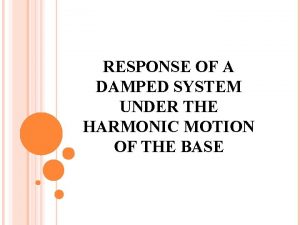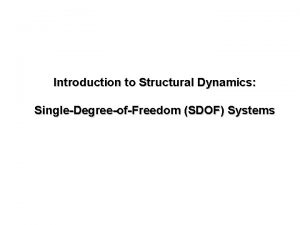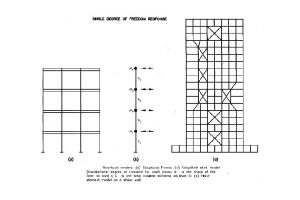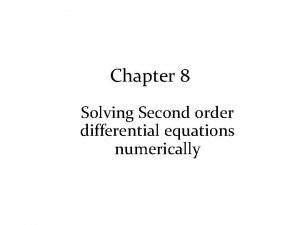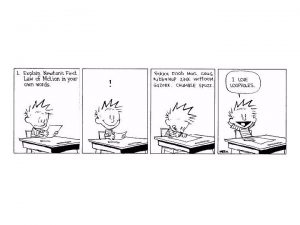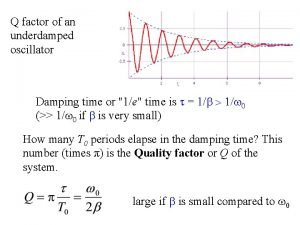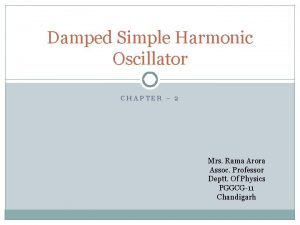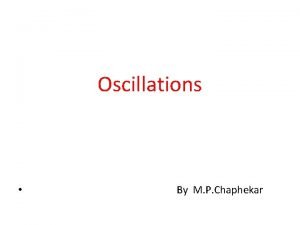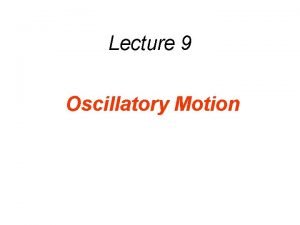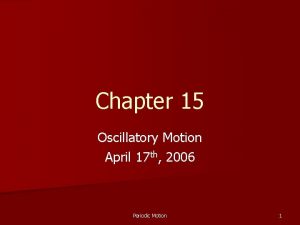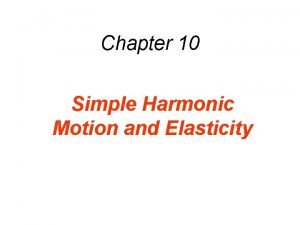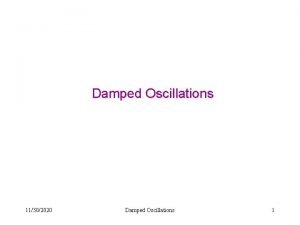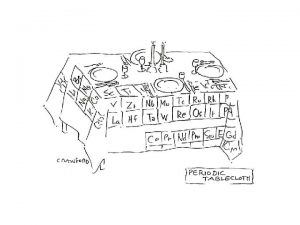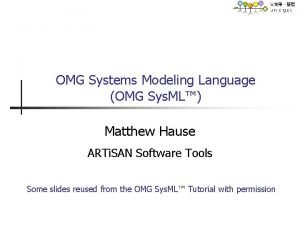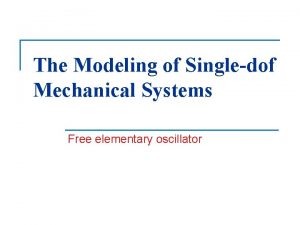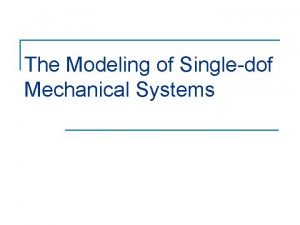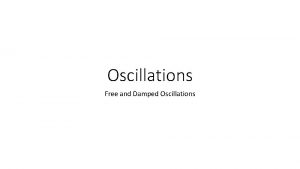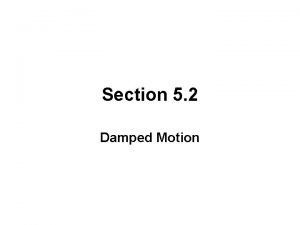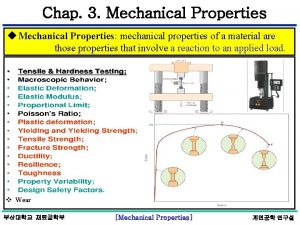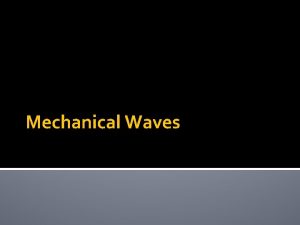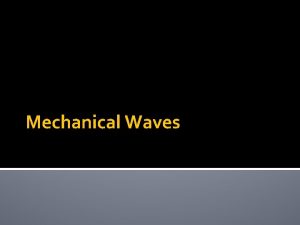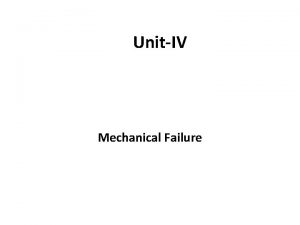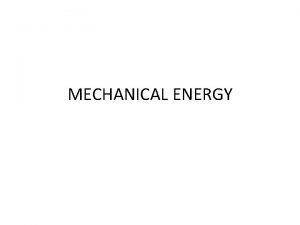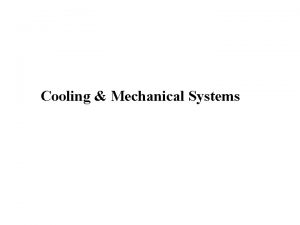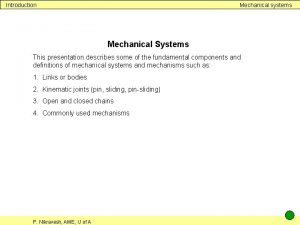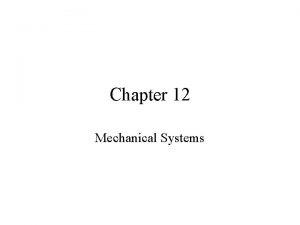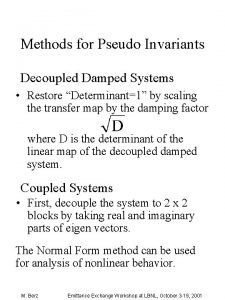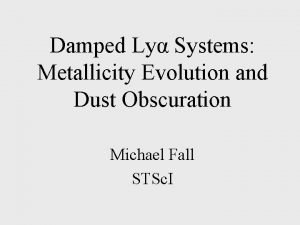The Modeling of Singledof Mechanical Systems Elementary damped




















- Slides: 20

The Modeling of Single-dof Mechanical Systems Elementary damped oscillator

Elementary damped oscillator Any real vibrating system dissipates energy because of the phenomena of friction, which is Coulomb, viscous and elastic hysteresis typical of real materials (in nature there are no perfectly elastic bodies which can be applied unconditionally hypothesis Hook). s Real bodies subjected to alternating stresses not run through periodically, in the two directions, the straight line that expresses the Hook's law, but run through a curve that inscribes always inside a e surface, whose area represents the amount of energy dissipated per cycle because of 'elastic hysteresis. Sistemi vibranti 1 g. d. l. - Oscillazioni smorzate 2 / 23

Elementary damped oscillator Linear Dashpots Sistemi vibranti 1 g. d. l. - Oscillazioni smorzate 3 / 23

Elementary damped oscillator Dynamic equation: dividing by m: where: Sistemi vibranti 1 g. d. l. - Oscillazioni smorzate 4 / 23

Elementary damped oscillator The solution of this differential equation of the second order, complete, linear and homogeneous is of the type: : by substituting in eq. Of motion whose roots are : according to the value of the discriminant may have three different solutions. Sistemi vibranti 1 g. d. l. - Oscillazioni smorzate 5 / 23

Elementary damped oscillator 1ª solution (critical damping) The parameter rc, said critical damping, damping the characteristic of the system itself, represents the particular damping value for which it has in the shortest possible time, compared to all other possible values of r, the return of the perturbed system in the configuration of static equilibrium. Sistemi vibranti 1 g. d. l. - Oscillazioni smorzate 6 / 23

Elementary damped oscillator 2ª solution (Iper-critical systems) The roots of the characteristic equation are real and both negative in the equation of motion becomes: Sistemi vibranti 1 g. d. l. - Oscillazioni smorzate 7 / 23

Elementary damped oscillator 3ª solution (Sub-critical systems) This is the case of greatest interest to the mechanical vibrations. The roots of the characteristic equation are complex and conjugate are given by the following equation: con eq. becomes: Sistemi vibranti 1 g. d. l. - Oscillazioni smorzate 8 / 23

Elementary damped oscillator 3ª solution (Sub-critical systems) From the second expression is immediate locate the motion of the mass m is a pseudo motion - periodical, with damped amplitude over time with exponential law. Sistemi vibranti 1 g. d. l. - Oscillazioni smorzate 9 / 23

Elementary damped oscillator 3ª soluzione (Sistemi sub critici) The natural frequency of the damped system is : being generally the term r/2 m very small, it can be easily approximated to the natural frequency of the free undamped system: Introducing the dimensionless ratio h and remembering the value of α, the period T of the damped oscillations can be expressed as: Sistemi vibranti 1 g. d. l. - Oscillazioni smorzate 10 / 23

Elementary damped oscillator Decremento logaritmico If h << 1 and is based on the measurement of free motion damped We consider: is constant To have a maximum: then We have +1 varing of n: Sistemi vibranti 1 g. d. l. - Oscillazioni smorzate 11 / 23

Elementary damped oscillator Decremento logaritmico the time ti is the instant which corresponds to a local maximum of x(t), the next maximum will use the instant (ti + T); then we have: The ratio of x(ti ) e x(ti+T ): then: Sistemi vibranti 1 g. d. l. - Oscillazioni smorzate logarithmic decrement 12 / 23

Elementary damped oscillator Decremento logaritmico If it excites any structure with an impulsive forcing is possible to obtain experimentally the diagram in Figure: it is possible to read the value of T and d, And a: Sistemi vibranti 1 g. d. l. - Oscillazioni smorzate 13 / 23

Example Coulomb damping: con Sistemi vibranti 1 g. d. l. - Oscillazioni smorzate 14 / 23

Example con Sistemi vibranti 1 g. d. l. - Oscillazioni smorzate 15 / 23

Example where C e j are constants to be determined by the initial conditions specific to each half-period of the oscillation. The constant term, denote by Δ, is the arrow static weight: Sistemi vibranti 1 g. d. l. - Oscillazioni smorzate 16 / 23

Example We impose the initial condition: Sistemi vibranti 1 g. d. l. - Oscillazioni smorzate 17 / 23

Example We impose the initial condition: Sistemi vibranti 1 g. d. l. - Oscillazioni smorzate 18 / 23

Example Therefore, the reduction in amplitude is for each oscillation complet. The found value of x 2 becomes the initial condition for the third half-period, and the process can be repeated until the end of the motion. . Sistemi vibranti 1 g. d. l. - Oscillazioni smorzate 19 / 23

Example When the amplitude of x(t) will be reduced to a value less than: cioè then the force of elastic of the spring, amounting to kxf will no longer be able to overcome the force of friction T At this point the motion stops. . Sistemi vibranti 1 g. d. l. - Oscillazioni smorzate 20 / 23
 Mathematical modeling of electrical systems examples
Mathematical modeling of electrical systems examples Helen erickson biography
Helen erickson biography Relational modeling vs dimensional modeling
Relational modeling vs dimensional modeling Response of an undamped system under harmonic force
Response of an undamped system under harmonic force Damped frequency formula
Damped frequency formula Degree of freedom
Degree of freedom Damped pendulum equation of motion
Damped pendulum equation of motion Damped pendulum equation of motion
Damped pendulum equation of motion Damped trigonometric functions
Damped trigonometric functions Q factor damped harmonic oscillator
Q factor damped harmonic oscillator Heavy damping equation
Heavy damping equation Damped oscillation
Damped oscillation Oscillation
Oscillation Damped oscillation
Damped oscillation Oscillation
Oscillation Damped oscilation
Damped oscilation Damped trend
Damped trend Graphical representation of shm
Graphical representation of shm Driven damped pendulum
Driven damped pendulum Actual mechanical advantage vs ideal mechanical advantage
Actual mechanical advantage vs ideal mechanical advantage Omg systems modeling language
Omg systems modeling language



